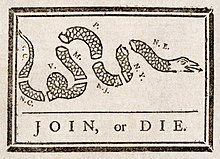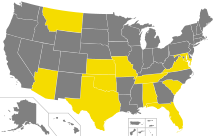
The national flag of the United States, often referred to as the American flag or the U.S. flag, consists of thirteen equal horizontal stripes of red alternating with white, with a blue rectangle in the canton, referred to as the union and bearing fifty small, white, five-pointed stars arranged in nine offset horizontal rows, where rows of six stars alternate with rows of five stars. The 50 stars on the flag represent the 50 U.S. states, and the 13 stripes represent the thirteen British colonies that declared independence from Great Britain, which they went on to secure by their victory in the American Revolutionary War.

Noli me tangere is the Latin version of a phrase spoken, according to John 20:17, by Jesus to Mary Magdalene when she recognized him after His resurrection. The biblical scene has been portrayed in numerous works of Christian art from Late Antiquity to the present. The phrase has also been used in literature, and later in a variation by military units since the late 18th century.

Christopher Gadsden was an American politician who was the principal leader of the South Carolina Patriot movement during the American Revolution. He was a delegate to the Continental Congress, a brigadier general in the Continental Army during the American Revolutionary War, Lieutenant Governor of South Carolina, a merchant, and the designer of the Gadsden flag. He is a signatory to the Continental Association.
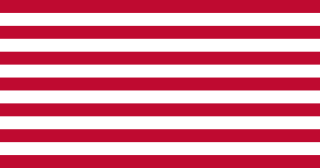
The Continental Navy was the navy of the Thirteen Colonies during the American Revolutionary War. Founded on October 13, 1775, the fleet developed into a relatively substantial force throughout the Revolutionary War, owing partially to the substantial efforts of the Continental Navy's patrons within the Continental Congress. These Congressional Patrons included the likes of John Adams, who served as the Chairman of the Naval Committee until 1776, when Commodore Esek Hopkins received instruction from the Continental Congress to assume command of the force.
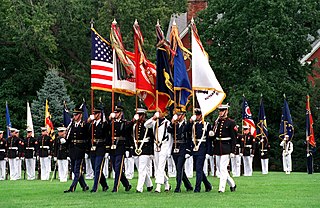
The several branches of the United States Armed Forces are represented by flags. Within the U.S. military, various flags fly on various occasions, and on various ships, bases, camps, and military academies.
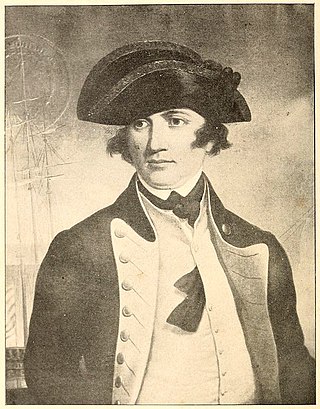
Esek Hopkins was an American naval officer, merchant captain, and privateer. Achieving the rank of Commodore, Hopkins was the only Commander-in-Chief of the Continental Navy during the American Revolutionary War. The Continental Congress commissioned him as Commander-in-Chief of the Navy in December 1775.

The First Navy Jack was the naval jack of the United States from 1975 to 1976 and again from 2002 to 2019. It was authorized by the U.S. Navy and was flown from the jackstaff of commissioned vessels of the U.S. Navy while moored pierside or at anchor. Since then, it is used only as a naval jack by the oldest active warship in the U.S. Navy. The design is traditionally regarded as that of the first U.S. naval jack, flown soon after independence, but this is not supported by the historical record.

The jack of the United States, referred to as the Union Jack by the U.S. Navy, is a maritime jack flag flown on the bow of U.S. vessels that are moored or anchored. In addition to commissioned U.S. Navy ships, the jack is used by the U.S. Coast Guard, the Military Sealift Command, the ships of the National Oceanic and Atmospheric Administration, and other U.S. government entities. While anchored or moored, the jack is flown on the bow of a ship, and the ensign is flown on the stern. Once under way, the jack is lowered.

The timber rattlesnake, canebrake rattlesnake, or banded rattlesnake is a species of pit viper endemic to eastern North America. Like all other pit vipers, it is venomous, with a very toxic bite. C. horridus is the only rattlesnake species in most of the populous Northeastern United States and is second only to its relatives to the west, the prairie rattlesnake, as the most northerly distributed venomous snake in North America. No subspecies are currently recognized.

Crotalus mitchellii is a venomous pit viper species in the family Viperidae. The species is endemic to the Southwestern United States and adjacent northern Mexico. The species was named in honor of Silas Weir Mitchell (1829–1914), an American medical doctor who also studied rattlesnake venoms. Five subspecies are currently recognized, including the nominate subspecies described here.

Join, or Die. is a political cartoon showing the disunity in the American colonies. Attributed to Benjamin Franklin, the original publication by The Pennsylvania Gazette on May 9, 1754, is the earliest known pictorial representation of colonial union produced by an American colonist in Colonial America.
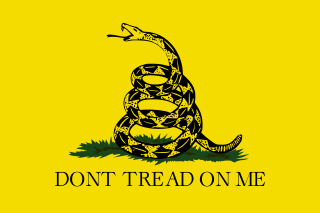
Don't Tread on Me, usually stylized in all caps without an apostrophe, is a political slogan dating to the American Revolution.

"Don't Tread on Me" is a song by American heavy metal band Metallica from their self-titled fifth album. The title is connected with the American Revolutionary War. The words "Don't Tread on Me" constitute the motto of the Gadsden flag, and the snake image on the flag is pictured on the cover of the album.

The Culpeper Minutemen was a militia group formed in 1775 in the district around Culpeper, Virginia. Like minutemen in other British colonies, the men drilled in military tactics and trained to respond to emergencies "at a minute's notice".
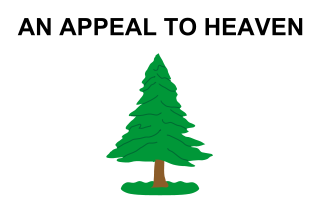
The Pine Tree Flag was one of the flags used during the American Revolution. The flag, which featured a pine tree with the motto "An Appeal to Heaven," or less frequently "An Appeal to God", was originally used by a squadron of six frigates that were commissioned under George Washington's authority as Commander-in-chief of the Continental Army in October 1775.
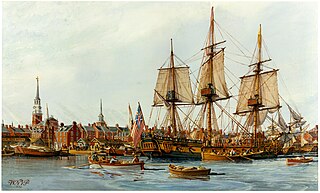
The Battle of Block Island was a naval skirmish which took place in the waters off Rhode Island during the American Revolutionary War. The Continental Navy under the command of Commodore Esek Hopkins was returning from a successful raid on Nassau when it encountered HMS Glasgow, a Royal Navy dispatch boat.

The United Companies of the Train of Artillery of the Town of Providence, known as UTA, is a member of the Rhode Island Historic Commands, and takes part in many reenactments and state events. The unit was raised during the American Revolutionary War from the Fusiliers of Providence and the Artillery Company of Providence, making it one of the largest artillery units in Rhode Island. They fought at the Battle of Rhode Island and many other battles in the American Revolutionary War. The unit used a distinctive flag which featured a coiled timber rattlesnake with the motto "Do Not Tread On Me", above an anchor and the motto "In God We Hope", and a pair of cannons. The motif was surrounded by thirteen stars on a field of gold. This flag is one of the earliest uses of a rattlesnake on a flag and may have been the basis for the Gadsden flag. It is also one of the first uses of a circle of 13 stars to represent the thirteen colonies.
SS Esek Hopkins was a Liberty ship built in the United States during World War II. She was named after Esek Hopkins, the only Commander in Chief of the Continental Navy during the American Revolutionary War. He was also an accomplished merchant captain and privateer. He is noted for his successful raid on the British port of Providence, in the Bahamas, and capturing large stores of military supplies.

The Whistleblower Protection Act of 1778 was an Act of Congress passed by the Second Continental Congress and signed into law by President of the Continental Congress Henry Laurens in 1778. It was the first piece of legislation concerning whistleblower protection in the United States passed by Congress. The act was created as a result of Continental Navy officer Esek Hopkins being reported on by fellow officers for torturing British prisoners of war. Congressional politicians, aware of the burdens the act placed on American civil servants, included in the act a provision for legal expenses in the event that whistleblowers were the subject of legal proceedings. Laurens signed the act into law in York, Pennsylvania on July 30, 1778.


